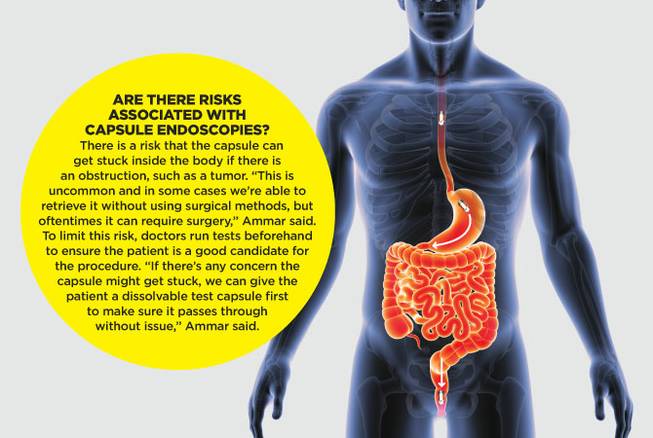
Monday, Jan. 22, 2018 | 2 a.m.
Meet the medical professional in this story
• Tarek Ammar, MD, Assistant Professor of Medicine, Roseman University College of Medicine and gastroenterologist at Southern Hills Hospital and Medical Center
The gastrointestinal tract is a system of organs susceptible to many diseases. Because this system is complex and delicate, doctors use advanced, and sometimes unusual, treatment methods. Two notable examples are capsule endoscopies and fecal transplants.
"Capsule endoscopies and fecal transplants are two very different medical solutions with very high success rates, respectively,” Dr. Tarek Ammar said.
Though unconventional, these techniques can offer lifesaving options to patients.
Capsule endoscopy
In a capsule endoscopy, a small device with a camera, battery and Bluetooth transmitter is placed inside a pill-like casing. Ammar notes that the capsules are about the size of large vitamin supplement and allow doctors to gather images of the digestive system when swallowed by the patient.
They can help diagnose issues in the small intestine if an upper endoscopy and colonoscopy aren’t able to find the problem. “Prior to capsule endoscopies, we weren’t able to take clear images of the entire small intestine in a noninvasive way,” Ammar said.
How the process works
• Step 1: The patient may need to prepare for the procedure by fasting or taking a mild laxative. From there, the process is as simple as going to the doctor’s office and swallowing the capsule.
• Step 2: The patient is fitted with a small receiver strapped around his or her abdomen. The receiver stores the images taken by the capsule endoscopy. Afterward, the receiver is returned to the doctor for evaluation.
• Step 3: The procedure is usually complete within eight hours, or whenever the capsule makes it through the digestive tract and passes in the stool. “The only thing the patient must do is check after they go to the bathroom to ensure the capsule has passed,” Ammar said. “Once they see the capsule, they can flush normally and go about their day.”
Are there risks associated with capsule endoscopies?
There is a risk that the capsule can get stuck inside the body if there is an obstruction, such as a tumor. “This is uncommon and in some cases, we're able to retrieve it without using surgical methods, but oftentimes it can require surgery,” Ammar said.
To limit this risk, doctors run tests beforehand to ensure the patient is a good candidate for the procedure. “If there’s any concern the capsule might get stuck, we can give the patient a dissolvable test capsule first to make sure it passes through without issue,” Ammar said.
Fecal transplant
Fecal transplants are used to treat a recurrent bacterial infection in the colon called Clostridium difficile colitis, or C-diff.
“C-diff is common in hospitals and nursing homes, but you can catch it in the community as well,” Ammar said.” It causes severe pain and bloody diarrhea, sometimes as often as 10-20 times a day.” While the first-line treatment for C-diff is antibiotics, some patients develop cases that cannot be managed by antibiotics alone and require fecal transplant.
The gut is filled with billions of “good” bacteria that keep us healthy. But for people struggling with recurrent C-diff colitis, the antibiotics used to treat the infection can kill the good bacteria and allow the bad bacteria to multiply. When this happens, the bad bacteria can grow and breed quickly because there’s not enough good bacteria to protect the gut.
At this point, the patient requires a fecal transplant, literally transplanting healthy fecal matter into the gut of the patient to repopulate the “good” bacteria.
How the process works
The fecal matter comes from a designated stool bank, where it’s tested for diseases and infections to ensure its safety. “Once we have the stool sample, we give the patient antibiotics to clear out all the bacteria, usually for about 7-10 days, and then we transplant the fecal sample before the bad bacteria has a chance to grow back,” Ammar said.
There are three ways the stool can be transplanted into the patient: during a colonoscopy, via a tube that is inserted into a patient’s nose into the stomach, or using a series of pills containing the sample.
Are there risks?
Ammar notes that fecal transplants have about a 90 percent success rate, with minimal risks. “Any transplant of bodily fluid carries the risk of infection, but the stool samples are tested for every known pathogen that could lead to infection,” he said.
